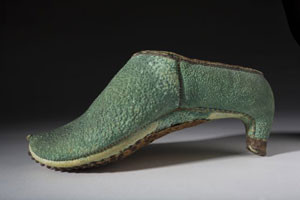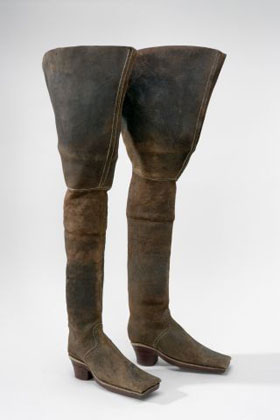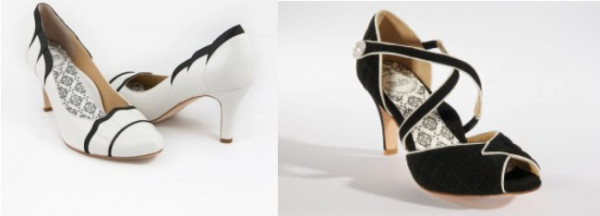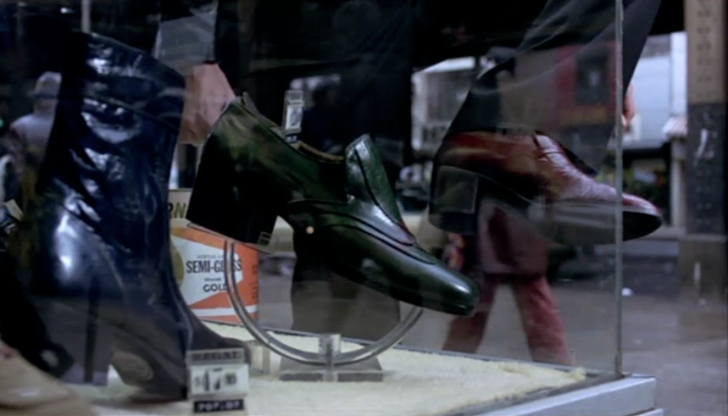As a fashion object and symbol, the high heel shoe is weighted with meaning. It’s also weighted with the wearer’s entire body weight. The stiletto might be one of the only designs that is physically painful but has somehow has persisted for centuries.
At their origins, high heeled shoes were originally worn by men. As early as the tenth century, many horseback riding cultures wore heels on their boots and on their shoes, because heels help you stay in the stirrups (which is why cowboy boots have heels).

The Persian cavalry, wore inch-high heels, and the trend spread to Europe. Since they showed that the wearer owned and maintained horses, high heels became associated with upper class practice.
Eventually, upper class women began wearing heels, and then heels become a form of upper- and middle-class dress throughout the 17th century.
At the time, high-heeled shoes were not a signifier of gender. When Louis XIV wore heels, he was dressing like the pillar of normative aristocratic masculinity he was.


Then heels started to get gendered in their designs. Men’s heels grew broad and sturdy and women’s became tapered and decorative. Finally, in the 18th Century, men deemed them impractical, and the high heel become firmly established as a lady’s shoe.
When the French Revolution mounted in 1789, the aristocracy and their frivolous styles went out of vogue. Heels, deemed the epitome of female irrationality and superficiality went out of fashion for a very, very long time.
And then camera was invented. With it, pin-ups.

Pornography embraced high, thin heels long before fashion did, because heels work great when you’re just posing for a few minutes. The pinups in men’s barracks during World War II almost always had high heels on them, and when the war ended and the men returned, the stiletto was invented, which brought fashion into alignment with erotica.
As heels made their way out of photography and into the street, and the office, and the home, engineering challenge arose around trying to make a fundamentally uncomfortable thing comfortable.
So people try to find ways around the design. There are foldable flat shoes that you can take with you when you just can’t stand the pain of a heel anymore, and the internet is full of hacks and tips:
In the most extreme cases, there are surgeries to shorten pinky toes and deaden nerves. All to circumvent the pain of the high heel.
With this pain in mind, twins Emily and Jessica Leung launched a wedding shoe line called Hey Lady.

The Leung twins designed some hacks into the high heel shoe, borrowing elements from other kinds of footwear. They took a toe box from a dancer’s shoe, which tends to be roomier, and they took the insoles and arch supports from running shoes. The Leung’s shoes go pretty high, but they are not stilettos. For balance purposes, the Leung’s made the heel thick where it meets the foot, but for aesthetics, the sturdy heel tapers to a finer point where it meets the floor.

Still, the Leung twins admit that even the most wearable heels have a time limit. They’ve engineered their shoes to last up to nine hours, but not for the whole day.
Industrial designer Martha Davis presented another approach, one based entirely on mathematics and measurements.

Davis studied the Lunati method of shoe-making in Milan; Lunati is all about crunching numbers and making sure the shoe is in ideal proportions.
Davis says a tall heel can be comfortable as long as the shoe fits properly, and there is one critical point where the fit really really matters. It’s called the Calzata, or “The Fitting Point.”
But regardless of how they fit, high heels on men have not made a lasting comeback.

99% Invisible Producer Avery Trufelman spoke with Elizabeth Semmelhack, curator at the Bata Shoe Museum; Emily and Jessica Leung of Hey Lady shoes; industrial designer Martha Davis; and All Things Considered host Audie Cornish.
Avery also wore a pair of heels for research purposes while reporting this story.



Comments (7)
Share
Great episode. I have been reading a lot about high heels lately; here is what bio mechanic Katy Bowman has to say about heels (actually any positive heeled footwear). ….http://www.katysays.com/are-high-heels-the-cigarettes-of-the-future/
i have NEVER understood why people wear heels. the worst part is that almost all dress shoes are high heels (or are matronly/ugly). Ballet flats were a thing for a couple of years but they are almost as bad since they have zero support.
I have feet. They provide all the support I need. I stand almost all day at work, either barefoot or something equivalent (currently a pair of FiveFingers because barefoot is a bit cold in winter). People don’t need artificial support in their footwear, they need to learn to stand properly and let their body do what it would do naturally if they hadn’t spent a lifetime teaching it the wrong things by wearing shoes.
relevant: https://www.youtube.com/watch?v=kc17H68IKMs
The reason the Canadian shoe museum is called the Bata Shoe Museum is because it was established by Tomas Bata, the Czech expatriate owner of the Bata Shoe company (http://en.wikipedia.org/wiki/Bata_Shoes). Bata (pronounced “bah-tya”) founded his company in Zlin, Czechoslovakia but escaped to Canada when the Nazis invaded in 1938. The factory complex was taken over by the Nazis who operated it through the war. But the shoe company resumed its original function after the war and continues to operate worldwide. The former headquarters in Zlin include a smaller shoe museum as well as several historic buildings, Bata’s “elevator office” and a film school and studio. I know all this because my father worked at the Bata film studio, also escaping (to the US) just before the Nazi invasion!
One note: The podcast says that heels were first used as a part of riding boots because “heels help you stay in the stirrups, which is why cowboy boots have heels.” In fact the opposite is the case. Heels PREVENT your foot from staying in the stirrup so that you are not dragged if you fall off. The idea is the heel is a stopper that prevents your foot from going all the way through a stirrup. If you can avoid getting stuck in the stirrup you and the horse will part ways as quickly and safely as possible.
That makes more sense!